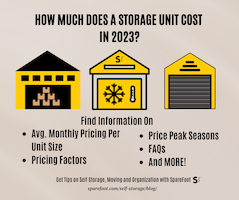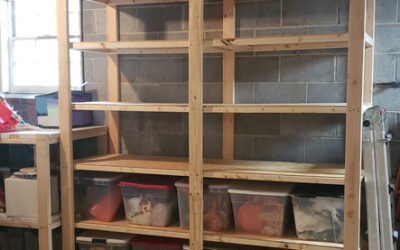Moving things to a storage unit seems straightforward, but many small details can trip you up. Whether doing it yourself or hiring help, a good plan can save you from headaches later.
You might find the storage unit too small after you start moving things in, or your precious items could get damaged without the right climate control. Security is another big deal. Imagine finding out too late that your storage unit didn’t protect against theft or that you forgot to get insurance for your valuables.
Thankfully, we know exactly what common mistakes to avoid when moving to a storage unit. Take a look.
Mistake 1. Not Researching Storage Facilities
Not all storage spots are created equal. Some may skimp on security and convenience, while others are the Fort Knox of storage. The latter are the ones worth investing in if you don’t want to risk damaged or stolen goods.
So, before you commit to a storage facility, ask yourself:
- Are there cameras and do they function 24/7? Is there a gate? Is someone watching the place day and night?
- Are you storing stuff that could warp or get damaged (like electronics, documents or a beloved guitar)? If so, choose a facility that offers climate control. If not, save a few bucks.
- Can you get to your stuff when you need to or are there limited hours? Depending on your schedule and habits, this can matter more than you first think.
Last but not least, compare deals for the same unit size and amenities at multiple facilities in your area. You don’t want to make your wallet weep by paying more than your stuff is worth.
Pro Tip: If you’re leaning toward utilizing a moving service, the good news is movers have no trouble delivering to storage units. All you have to do is snag yourself a storage unit and let your movers know where to drop off your belongings.
Mistake 2. Underestimating Storage Needs
Ever tried fitting into pants two sizes too small? That’s what shoving too much into a tiny storage unit feels like. Not a good look, and not good for your belongings. To dodge this misstep, a little homework and a tape measure are your best friends.
- First, list all the items you’re storing. Big, small, weird shapes – everything.
- Boxes are great because they’re easy to stack, measure and maneuver but you can’t fit everything in a box. So, tally up box counts and measure bulky items like furniture. Consider some wiggle room for them.
- Visualize if you can fit all items in a single room without playing a risky game of item Jenga. That’s your first storage unit size cue. Next, size up a bit. Not only for an aisle, but extra space is a safety net for future you.
- Storage unit managers know their stuff. Ask for floor plans to figure out what goes where best and see if you can snag potential discounts for longer stays.
Pro Tip: For immediate storage, group all your soon-to-be-stored items in one home spot. It doubles as a space estimator and pre-move organizer as you can use that staging area to store your stuff before you move to storage.
Mistake 3. Improper Packing
Proper packing is your armor against the rough-and-tumble of moving and storing, so invest in quality packing supplies and take the time to pack with care. Too generic? Here’s how to shield your belongings:
- Sturdy boxes are your first line of defense. Reinforce their bottoms and seams with strong packing tape. No flimsy boxes allowed.
- Don’t skimp on bubble wrap and packing paper when dealing with fragile items. For extra safety, consider bagging and vacuum-sealing textiles like clothes or bedding, as they are prone to moisture damage.
- Wrap tables, chairs and other furniture pieces in covers to fend off dust bunnies and scuffs. Leave some space between items in the moving truck and then in the storage unit to prevent surface damage.
- Label each box with its contents or assign numbers and keep a master list. A marker in time can save you hours of searching later.
- Opt for breathable covers rather than sealing everything airtight. Airflow is key in preventing moisture buildup and mold.
Pro Tip: Would you be better off with a packing service? Movers can offer expert packing, ensuring your items are snug and secure for their storage stay.
Mistake 4. Ignoring Climate Control
Not all treasures thrive under the same roof, especially when that roof doesn’t cater to their climate needs. Extreme temperatures and humidity are like kryptonite to certain items. Here’s a quick glance at what really craves that temperate, stable environment:
| Item | Why It Needs Climate Control |
| Bedding & Mattresses | Avoids mold and mildew from moisture. |
| Sports Equipment | Prevents warping and moisture damage. |
| Musical Instruments | Keeps warping and humidity damage at bay. |
| Books & Paperwork | Stops pages from sticking and colors from fading. |
| Photos & Documents | Protects against sticking, fading and moisture damage. |
| Leather Goods | Prevents cracking and warping from humidity. |
| Wooden Furniture | Stops warping, cracking and discoloration. |
| Electronics | Shields from moisture damage and circuit malfunctions. |
| Vinyl Records | Prevents warping and sound distortion. |
| Collectibles | Preserves condition, preventing warping and fading. |
Remember, the climate your storage unit lives in plays a huge role. Hot, humid, cold or dry – each brings its own brand of chaos to your valuables. If extreme cold is your only concern, heated units are your go-to. But for the full spectrum of protection, climate-controlled storage is the way to keep your stuff just as you left it. Short stint or long haul, the duration matters too. Short-term might slide, but long-term without climate control? That’s a gamble.
Mistake 5. Neglecting Security Measures
You’ve packed and stored your belongings with care. It would be quite a shame to realize the storage facility is not as safe as you hoped. Here’s what you should look for before moving to a storage unit:
- Start with a storage facility in a safe area. It’s your first layer of defense.
- Ensure enough cameras are watching over the place. More eyes, less chance for mischief.
- Cameras aren’t everything. Ask if there’s regular patrolling and how often they check the footage. For extra peace of mind, consider a facility with a resident manager.
- The storage facility grounds should have a gate, with access limited to those who have business there, and a good fence and perimeter security.
- Factor in lighting and visibility. Well-lit areas deter unwanted visitors.
- Some places offer units with individual alarms for that extra peace of mind. If not, invest in a high-quality lock for your unit.
- Check for smoke detectors and fire extinguishers. Dry chemical fire suppression systems are a plus, as water-based ones will cause additional damage.
Mistake 6. Poor Organization
Having an organized storage unit is not the first thing that comes to mind when you stash things away. Understandable, but it’s not neatness itself that is the issue here. The thing is proper organization offers ease of access. You do want to avoid the dreaded domino effect of toppling boxes, right?
- Think of your storage unit like a grocery list. Items you’ll need often? Put them at the front. The holiday decorations can hang out in the back.
- Create pathways within your unit and make sure box labels are facing the aisle.
- Draft a simple map of where things are and tape it somewhere close to the entrance. Keep a digital copy on your phone.
- Boxes should be snug but not squeezed to keep your items in good shape yet prevent them from collapsing.
Mistake 7. Not Insuring Belongings
It’s easy to assume your stuff is safe once it’s locked away in a storage unit, but life has a way of throwing curveballs. Storage units can face break-ins, natural disasters or even a pesky leak. Know what risks your belongings might be exposed to and look for a plan that covers them. Also, make a detailed list of everything you’re storing. On the off chance you need to make a claim, this list is golden.
Before you sign anything, start by checking existing policies. Your homeowner’s or renter’s insurance might offer some coverage for items in storage, but it’s often limited. Note that they might cover the weight, not the actual value, of your items. Now, if you’re storing a painting or a high-end laptop and something happens, getting reimbursed for just the weight won’t cut it.
Pro Tip: Always read the fine print of any insurance policy. What’s not covered is just as important as what is. And keep an eye out for exclusions like flood damage or vermin, which can sneak up on you.
Mistake 8. Rushing the Process
Planning your move to storage avoids the chaos of a last-minute rush. And we all know what that feels like, right? Rushing can make you miss important steps, like finding the right storage or packing your items properly.
To dodge that bullet, start planning the moment you know you’ll move belongings to storage. Draft a detailed plan with a timeline, with enough breathing room to make informed decisions — don’t underestimate the time it takes to pack and organize.
Write down what needs to happen first and set a deadline for choosing a storage unit. Attach a detailed checklist to that plan. A checklist of tasks for before, during and after moving to a storage unit keeps you on track.
Mistake 9. Ignoring Access Needs
Easy access to your storage unit should be among the top things on your list when choosing a storage facility, especially if you might need to retrieve or add items periodically.
- Choose a storage facility that aligns with your schedule. Need something at odd hours? Look for 24/7 access.
- If frequent visits are on the cards, pick a unit that’s not a trek away.
- Need to transfer bulky items? A storage unit with drive-up access can make that easier.
- Some places have specific rules about access. Get the scoop upfront and understand policies to avoid surprises later.
Wondering if movers can help shuffle things in and out of your unit without you breaking your back? They sure can. Just inform the storage facility and make all necessary arrangements.
Mistake 10. Not Decluttering Beforehand
Wondering why decluttering before moving things to a storage unit is a good idea? Well, stashing everything you own into storage, even the stuff you haven’t seen in years, is only going to bump the moving and storage bills up for nothing. The less you store, the less you pay.
- Before you even touch a box, sift through your belongings. That scarf you never wear? The gadgets you never use? It’s time for them to go.
- Items in good condition can find a new home or bring in some extra cash. Whether you donate or sell them, it’s better than paying to store things you don’t need.
- Note that not everything will be worth saving or selling. Be honest about what’s just taking up space and straight up discard it.
Your Move to Storage Just Got Smoother
Moving to a storage unit can be a source of stress, we know that all too well, but it doesn’t have to be like that. Pay attention to the details, from choosing the right facility and packing with care to ensuring top security and avoiding the rush with a well-thought-out plan.
The effort you put in before the move to storage pays off in peace of mind. After all, whether it’s memorabilia or not, your belongings are tiny parts of your life. Protecting them with a little planning and knowledge means they’ll be there for you, safe and sound, whenever you need them again.


